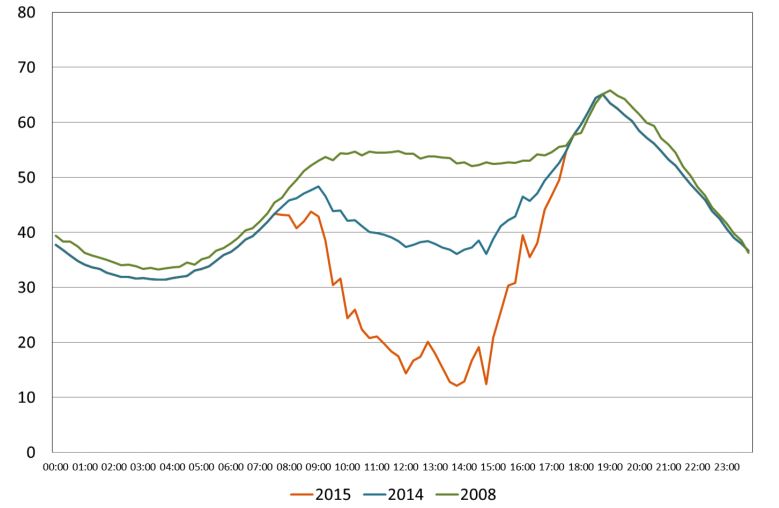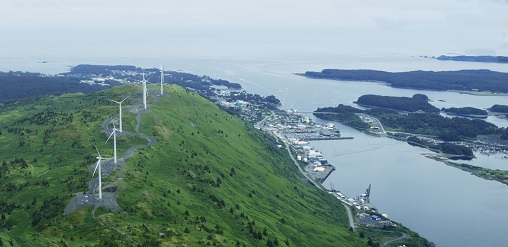Access to a large electric system provides big economies of scale not only in terms of diversity and low cost of power generation, but even more so for minimizing necessary reserves and for making it easier to balance variable resources like wind and solar.
Islands without access to neighboring electric systems are in every aspect on their own. They have to generate all the power they need and they must themselves keep the system reliable no matter what. Adding more renewable energy to an island system can be an opportunity, but large amounts of variable renewable energy increases the challenge of maintaining reliability at reasonable costs.
Two islands, Kodiak (Alaska) and Kauai (Hawaii) are great examples of demonstrating what can be done. There are several lessons to be learnt for other islands, microgrids or other isolated systems. Some aspects, like managing large amounts of distributed and behind-the-meter generation, are also of interest for large interconnected systems.
Kodiak, an island with a population of 13000, has a peak demand of close to 28 MW. In 2007 the Kodiak Electric Association (KEA) set a target to cost-effectively generate 95 % of its electricity from renewable resources by 2020. Not only have they exceeded its goal but they have done it ahead of time. Kodiak now generates 99.7 % of its energy from renewables. The rates are 14-15 cents per kWh, which is less than the average 18 cents per kWh for Alaska. In fact the Kodiak rates are now 2.5 % lower than 2001.
The biggest key factor for the success is the hydro power, which delivers over 80 % of the electricity. The hydro power station at Terror Lake, located about 40 kilometers (25 miles) from the city, was originally constructed in 1985 by the State of Alaska for $230 M. It had two units rated at 11 MW each. Fortunately the dam, diversion channels and other parts of the related infrastructure were sized that a third turbine rated 11.5 MW could be added in 2013.
Since KEA wanted to reduce the need for the back-up diesel generators when not all three hydro generators are available, they also installed three 1.5 MW wind turbines at Pillar Mountain in 2009. With the variable wind came stability (frequency and voltage) challenges. As a result in 2012, when three more 1.5 MW wind turbines were added to the system, KEA also installed a 3 MW/2 MWh “advanced lead acid” battery systems from Xtreme Power to provide 30-90 seconds of bridging power.
However, with the planned installation of a 2 MW crane in the harbor KEA will face additional stability challenges. To mitigate those challenges as well as reducing the stress on the battery system KEA has contracted with ABB to install two 1 MW flywheel systems.
Going 99.7 % renewable energy KEA has eliminated the annual need of 2.8 million gallon of diesel fuel, a saving of $7 M. For the investments KEA received a $16 M grant from Alaska Energy Authority and $39.6 M through clean renewable energy bonds (CREBS) at near zero interest.
Kauai, the northernmost of the Hawaii islands, has a population of 67,000 (2010 census and not counting the tourists) and all-time peak at 78 MW (2007). Kauai Island Utility Cooperative (KIUC) was formed in 1999 and by acquiring Kauai Electric in 2002 became the electric utility for the island. KIUC faced two major challenges: very high electricity prices and over 90 % of all electricity produced using oil. From 2010 KIUC also faced the additional challenge of fast growth of rooftop solar, up 600 % in five years (2010 – June 2015). This behind-the-meter generation combined with improved energy efficiency has resulted in negative load growth.
Facing these almost overwhelming challenges KIUC set up a Strategic Plan 2009, which was updated 2013. The plan targets by 2023 to generate at least 50 % of electricity by using renewable resources, to reduce carbon emission levels below 1990 levels, to decrease average residential bill by 10 %, to hold controllable cost increases below level of inflation while maintaining reliability, and to be a leader in energy storage technology.
The results so far are impressive. This year about 38 % of the electric energy produced will be from renewable sources (hydro 9 %, biomass 12 % and solar 17 %). It translates to 2.6 M fewer gallons of oil used and greenhouse gas emissions down by 9 %.
Electricity prices, helped by the drop in oil prices, have recently (September 2015) come down to 31 cents per kWh. Noticeable is also that between 2008 and 2014 KIUC electricity prices have been basically constant, while the other Hawaii islands have seen increases between 4.4 % (Maui) and 28.3 % (Oahu).
What really makes KIUC achievements so impressive is how they manage to accommodate a very high amount of solar, both utility scale solar as well as rooftop solar, without any surrounding grid to help balance the variability.
KIUC has now 31.6 MW of solar farms. In addition there are about 18 MW of rooftop solar on the customer side of the meter. In fact through June 2015 there were 2911 interconnections, which is over 9 % of all KIUC customers. At midday on a sunny day about 2/3 of all electricity produced and consumed is solar. It has peaked at 70 %!
With the high solar penetration has also come the “duck curve”. The chart below shows the daily load demand on non-solar generation. The change from 2008, when there was almost no solar to present is remarkable and very challenging to manage without access to a large neighboring electric grid.

Example of adaily load profile for the non-solar generation. Vertical axis is MW of load. The all-day peak remains between 6 pm and 8 pm, but after all solar generation at mid-day is over a steep ramp up of the non-solar generation is needed from 3 pm.
In order to balance the variability of solar and to have the flexibility to ramp up, when solar is not available KIUC relies on its installed fleet of conventional generators and made various efforts to improve the flexibility of the units. For example KIUC has modified their gas turbines to be able to operate between 25 % and 100 % of rated power. In addition KIUC has invested in battery energy storage. The first battery system, installed in 2012, was three 1.5 MW/1 MWh “advanced lead acid” batteries from Xtreme Power. The main purpose was to provide fast frequency and voltage control in response to “extreme ramp events”. Unfortunately, the stress on the battery systems turned out to be more than expected, which substantially limited the useful capacity of the battery.
Using lessons learnt KIUC decided to add a 6 MW/4.63 MWh lithium battery system by SAFT in direct connection with its new 12 MW solar farm at Anahola, which went live this year. The larger sized battery and a lithium ion chemistry capable of rapid cycling will be much more suitable for handling the fast frequency and voltage control. In addition the lithium ion battery should also be useful in storing excess solar generation.
The next step in the evolution of the battery application was announced in September this year. KIUC signed a 20 year power purchase agreement (PPA) with Solar City at 14.5 cents per kWh. In this first application of dispatchable solar the battery is intended for diurnal storage, moving the peak 3-5 hours. Solar City targets to have the 12 MW solar farm and the 13 MW/52 MWh battery system in operation before end of 2016.
In addition to pioneering battery storage KIUC in order to accommodate the large amounts of behind the meter solar has been creative with a variety of business solutions. After the net metering pilot, which was capped at 1 MW, quickly was reached, they launched a Tariff Q program, which is structured similar to the PURPA (Public Utility Regulatory Policies Act) principle (payments at the marginal cost of its own power generation). As a result KIUC get about 2.6 % of its energy sales from customer solar generation. They expect to be able to grow it to 3.4 % by 2016.
Another proactive approach is the concept of community solar. Based on the thinking that all customers do not have suitable roofs for solar and that utility solar has the economy of scale, KIUC in November submitted a proposal for a 3 MW community-based solar program to Hawaii Public Utility Commission for approval. KIUC also in September announced a Time-of-Use Solar Pilot Program. The program will be limited to 300 residential customers a 25 % discount on standard rates from 9 am to 3 pm.
KIUC is on track to exceed its strategic goal of at least 50 % renewable energy by 2023. They may even reach 66 % (hydro 18 %, biomass 12 % and solar+storage 36 %). To do so it will be crucial to grow the hydro power, both conventional hydro as well as pumped hydro. KIUC is actively looking at a 25 MW pumped hydro storage. It will go a long way to enable further solar expansion by load shifting solar to evening peak demand and help avoiding curtailment of solar generation. In addition evening hydro generation will offset fossil fuel generation.
Kodiak/KEA and Kauai/KIUC both show accommodating a large amount of renewable energy can be done without jeopardizing reliability and keeping costs affordable. For islands electricity will always be more costly than when you have access to a large electric grid. Nevertheless, if done right, optimizing the locally available renewable resources, taking advantage of federal and state programs, low interest bonds as well as competitive PPAs, Kodiak and Kauai demonstrate it can be done at a lower cost than just sticking to the traditional fossil fuel solutions and business as usual.
Additional reading:
RMI. Renewable Microgrids: Profiles from Islands and Remote Communities across the Globe. (2015).
NRECA. CRN. Case Study. Kauai Island Utility Cooperative: The Impact of Extensive PV Penetration. (2014)

